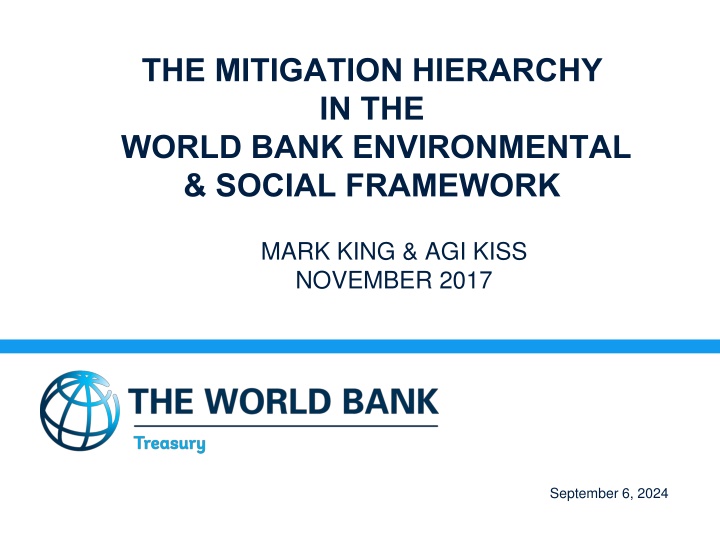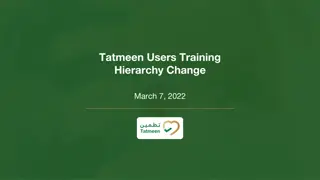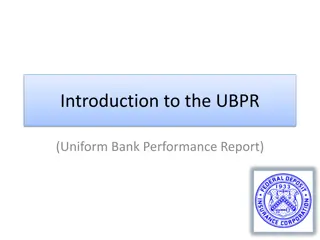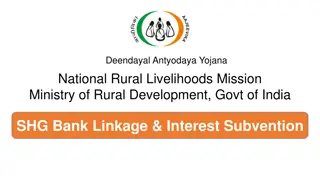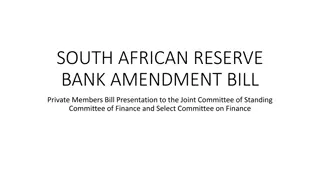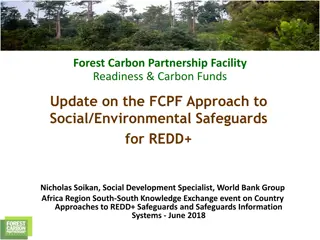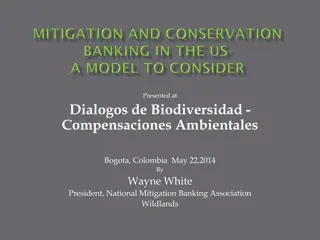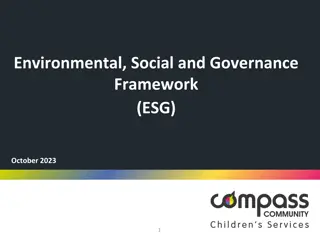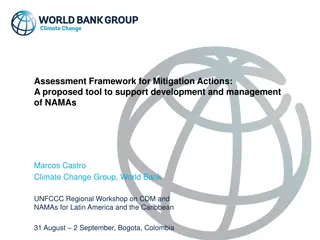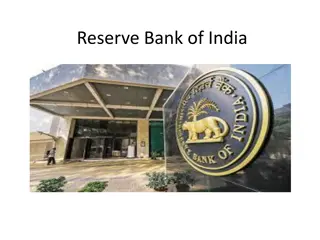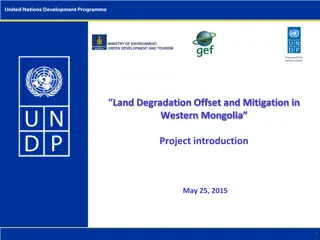The Mitigation Hierarchy in the World Bank Environmental & Social Framework Overview
The content discusses the Management of risks and impacts within the World Bank's Operational Policies and Bank Procedures, highlighting the incorporation of the Mitigation Hierarchy in the Environmental & Social Framework. It addresses key elements, drivers, challenges, and the need for clarity in roles and responsibilities. The shift towards an outcomes-based approach and the importance of stakeholder engagement are emphasized.
Download Presentation

Please find below an Image/Link to download the presentation.
The content on the website is provided AS IS for your information and personal use only. It may not be sold, licensed, or shared on other websites without obtaining consent from the author.If you encounter any issues during the download, it is possible that the publisher has removed the file from their server.
You are allowed to download the files provided on this website for personal or commercial use, subject to the condition that they are used lawfully. All files are the property of their respective owners.
The content on the website is provided AS IS for your information and personal use only. It may not be sold, licensed, or shared on other websites without obtaining consent from the author.
E N D
Presentation Transcript
THE MITIGATION HIERARCHY IN THE WORLD BANK ENVIRONMENTAL & SOCIAL FRAMEWORK MARK KING & AGI KISS NOVEMBER 2017 September 6, 2024
OVERVIEW Management of risks and impacts within the current Operational Policies and Bank Procedures (Safeguards) Key elements and drivers of the ESF How the Mitigation Hierarchy is incorporated in the ESF (cf other IFIs and Development Partners) Implications for investment lending and players in development
Management of risks and impacts within the current Safeguards 8 environmental and social OPs and 2 legal ones were developed over a 20 year period and vary in style, level of detail etc. The safeguards do not explicitly address the full range of E/S risks and impacts expected today Mitigation Hierarchy not explicitly a core element of the procedural fabric of E/S risk management Current safeguards have less direction/detail on the procedural approach leaving much to judgment and inference. Roles and responsibilities not always clear 2
Key elements and drivers of the ESF (1) Our 189 shareholders Need to improve our game across the board (consistency, approach during appraisal, monitoring/supervision) Emerging Issues needed to be addressed More clarity required on roles and responsibilities (accountability, transparency A shift from front-loading to an outcomes based approach 3
Key elements and drivers of the ESF (2) Harmonization agenda Moving from one-size-fits all to a more client focused and tailored approach (South Sudan to Poland) Our portfolio is becoming more challenging (Fragile, Conflict, Violence, emergency response etc) 4
Key Thematic Elements of the ESF Delineating and limiting project risks and liabilities Outcomes materially consistent with the objectives of the ESSs Inclusive, non-discriminatory approach (WB s Twin Goals) High standards set by ESSs, EHSGs and GIIP Risk based approach More emphasis on judgment rather than a rule based approach Control or influence Manner and timeframe acceptable to the Bank Technically and financially feasible Adaptive management (ongoing stakeholder engagement) 5
The Mitigation Hierarchy within the ESF Explicitly referenced and/or described throughout ESF and related material: Vision Statement Environmental and Social Policy (Bank) Directive re marginalized/vulnerable (Bank) Environmental and Social Procedure (Bank) Best Practice Notes and other tools (Bank) Ten Environmental and Social Standards (Borrower) Guidance Notes (Borrower) 6
Elements of the WB Mitigation Hierarchy Anticipate and avoid risks and impacts Where avoidance is not possible, minimize or reduce to acceptable levels Once risks and impacts have been minimized or reduced, mitigate (inc improve or at least restore livelihoods) Where significant residual impacts remain, compensate or offset them, where technically and financially feasible 7
Leads to more realistic and reasonable outcomes? Mitigation Hierarchy focuses on risk (downside) not upside except in ESS 2, 5,6,7 IPs, resettlement, Staff Directive (differentiated measures) Conditioned by proportionality, control and influence, manner and timeframe acceptable to the Bank, technically and financially feasible Minimize or reduce to acceptable levels (what is acceptable and who determines?) Higher bar for compensation and offsetting (where significant impacts remain (threshold?) 8
Implications for investment lending and players in development ESF requires rigorous application of the MH for all risks and impacts Knock-on effect is more rigorous E/S assessment process (scoping, stakeholder engagement, baseline etc) Higher expectations regarding documenting rationale for decision- making Strong feedback loop (monitoring and stakeholder engagement) supporting adaptive management Burden of proof lies with Borrower and Bank staff (esp Staff Directive) 9
Implications for Borrowers More rigorous collection of baseline data Improvements in stakeholder engagement Improvement in ESA practice Enhanced skills and knowledge base (hiring, more use of consultants?) Timely better sequenced actions and processes Budgetary implications? Internalizing the cost of the MH may make projects unfeasible (always a possibility but often ignored!) Much scope for efficiency gains! 10
Implications for Borrowers Doing things better: more resources Enhancing skills base especially for new issues Culture change: moving to judgment, risk based approach, making decisions! More hand-holding for Borrowers; at least initially Accountability and transparency> risk adversity? Much scope for efficiency gains Better placed for challenging lending environments 11
Implications for Technical Experts High expectations to be met in terms of technical expertise and support to clients More rigorous ESA practice Better baseline (timing, sequencing, resources) ESF is holistic: skills and staffing implications Role of niche consultancy v big game firms Need for local partners intensified; esp re stakeholder engagement and on social issues 12
Implications for people and the Environment Broader range of protections More rigorous processes leading to better development outcomes Leaving no-one behind: Non-discrimination, inclusion and differentiated mitigation measures Higher burden of proof linked to ESS6, ecosystem services and the precautionary approach contribute to stronger protection of biodiversity and habitats Better monitoring and stakeholder engagement allows for effective adaptive management 13
TBILISI URBAN REGENERATION Old residential to mixed apartment/retail A project (OP), High risk project (ESF) Several IFIs and FIs involved Scoping Stakeholder engagement Staff Directive .
Ombla Underground Hydro, Croatia Karstic cave system Endangered amphibian present? Baseline sampling: cave diving, DNA testing No amphibian but 20 approx. new invertebrate species Offsetting proposed: species will move to new tunnels when hydrological regime changes. Adequate? Precautionary? Adaptive management?
Sakhalin Oil and Gas Developments Full-field vertically integrated offshore production. Pipeline to shore through proposed through Western Gray Whale calving/feeding area Onshore pipeline over 8800km crossing 1000 approx. rivers/streams Transmission line and Steller s Sea Eagle
